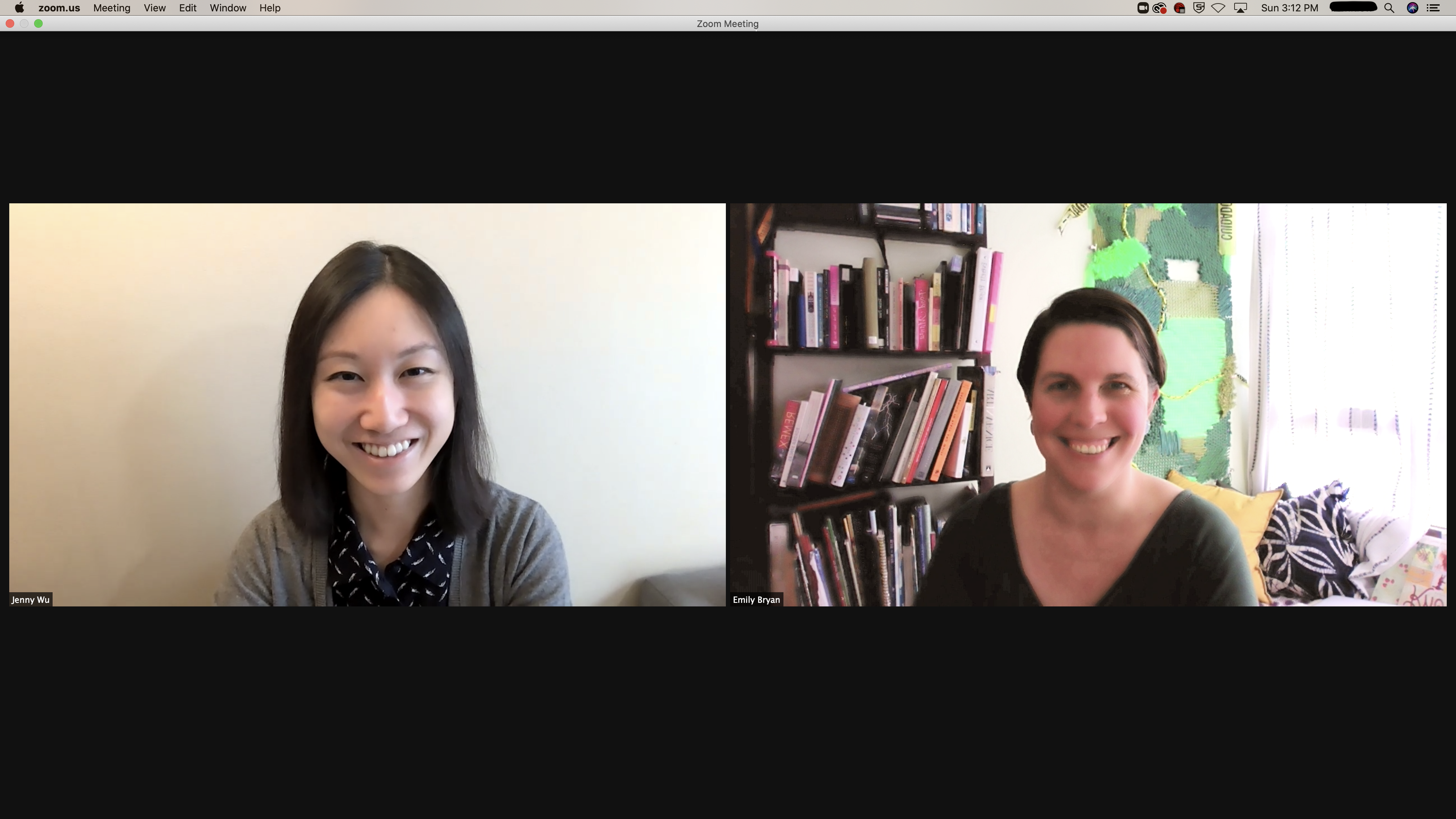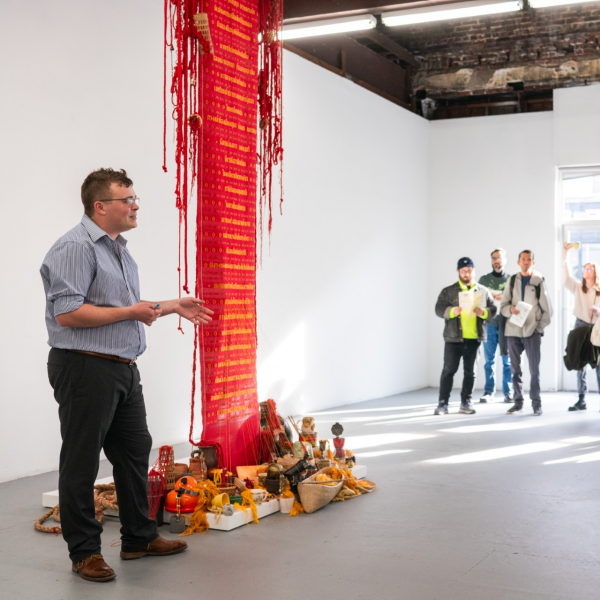As students, Bryan and Wu describe the past year and a half as a mercurial constellation of exciting opportunities and disappointing cancellations. In the short few months of their semester-and-a-half before lockdown, they had the chance to work together on a podcast in a class, were roommates at CAA in Chicago, and despite the weirdness of pandemic year, have managed to stay connected across the virtual divide. They have become experts at presenting in the virtual spaces of videoconferencing and online exhibitions, and have served the department behind the scenes through building Canvas courses and monitoring online class sessions. All in all, they have a lot to brag about, having pursued and presented their own research in a variety of venues.
Wu, who holds an MFA in creative writing, came into the AM in AH&A eager to research global contemporary art with a specific focus on Chinese performance art and visual culture. In 2020, her publications included an essay “Douce Mélancholie: Sonic Negotiations of Absence in the Works of Susan Philipsz and Félicia Atkinson” in Refract Journal, which she also presented as a talk at the Refract Symposium: Hauntings and Traces hosted online by the University of California Santa Cruz. She contributed online catalogue entries to two exhibitions on campus as well, including an essay about Ryan Erickson’s The Shape of Language, in the MFA exhibition A Transitory Space, and her essay “Feet, Hands, and Tongues: Reading Cristina Rivera Garza in Oct. 2020,” was published in conjunction with the exhibition Hostile Terrain 94. Furthermore, her interview with St. Louis artist Mee Jey, “‘I Want to Carry All of It’: Mee Jey & Jenny Wu in Conversation,” appeared in REMAKE Journal.
In addition to the Refract Symposium, Wu presented a conference paper titled “Against Motility: inSITE, Mika Rottenberg, and the Position of the ‘Border Outsider,’” at the 76th Annual Meeting of the Southeast College Art Conference at Virginia Commonwealth University. Another paper, titled “From Kunstkammer to Cosmic Sympathy: Hybridity and Likeness in the Art of ruby onyinyechi amanze and Wura-Natasha Ogunji,” was accepted to the 25th Annual Graduate Student Symposium at University of Alabama at Birmingham. In spring 2021, she appeared as a guest in Dr. Michael Sanders’s class titled “Topics in Literature: You are Being Watched: The Work of Art in the Age of Surveillance Capitalism,” giving a lecture based on her study of Xu Bing’s film Dragonfly Eyes (2017).
One of the highlights of Wu’s time in AH&A was giving an hour-long New Perspectives Gallery Talk online through the Mildred Lane Kemper Art Museum. The talk, titled “To Do Without People: Moyra Davey’s Impossible Renunciation,” examined the absence of figures in four of Davey’s photographs in the Kemper’s collection in relation to French filmmaker Louis Malle’s notion of “image theft.” Wu hopes to continue contributing to art spaces as the Pulitzer Arts Foundation’s Graduate Curatorial Intern for Summer 2021.
Bryan presented at her first conference in January of this year, with her paper “Holding them in our Hearts: Walking With Our Sisters and Memorial Art as Decolonial Act,” at the Context & Meaning Graduate Symposium at Queens University in Kingston Ontario, and she looks forward to presenting “Memory, Material, and Manipulation: Notions of Home, Nationalism, and Identity in the Recent work of Katrin Sigurdardottir” at the (Art)iculations Graduate Symposium at University of California Riverside in May 2021.
In the fall of 2020, Bryan completed and published, together with instructor Gavin Kroeber and classmate Jess DeAngelo, Laboratory for Suburbia: An Atlas of Interrogative Art and Design Practices. This book presented work by members of the class ARCH 430F in the Sam Fox School last spring, a project which evolved when the planned exhibition was cancelled. Bryan contributed the curatorial essay, several object entries, and co-edited the volume with Kroeber and DeAngelo. She then led the book’s presentation and discussion during a virtual launch in November. She, like Wu, contributed an essay to A Transitory Space online MFA exhibition, on Amanda Cassirez’s wearable sculptures. Bryan also appeared as a guest in Dr. Christi Smith’s International and Area Studies research methods class where she discussed how international travel has influenced her research interests and on the challenges and rewards of returning to graduate school after time away from academia.
Last spring, with the University’s quick shift to online instruction, both Wu and Bryan saw their roles as Visual Resource Collection fellows change drastically. While challenging, the change gave them the opportunity to both gain skills in online course building and support faculty and fellow students in meaningful day-to-day ways. “I thoroughly enjoyed learning how to build Canvas course pages based on a paper syllabus and support my instructors,” says Bryan, “and now I have a whole new set of marketable skills to add to my resume as I jump into the job market.” Wu, who has also served the department by editing and publishing the annual newsletter, building a social media presence, and updating the website, feels similarly: “I enjoy projects with a design element to them, and Betha Whitlow (VRC Curator) has taught me well.”
After graduating, both Bryan and Wu will stay connected to the department as they serve on the committee organizing the 2022 Graduate Art History Symposium, with Bryan serving as a co-chair. The bi-annual symposium will likely take place in February to correspond with graduate recruiting weekend. The two plan to stay in touch and hopefully work together again in the future. “I see a lot of potential for our varied interests and skills to combine for great things to come, so stay tuned!” says Bryan. . .over zoom, of course. “Even working on this story reminds me of our podcast project last year,” says Wu, “I think we’re a very functional team.” Despite the weirdness of the last year, which lacked some of the typical classmate camaraderie, they are grateful to have established this lasting friendship.




